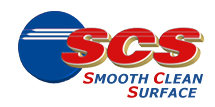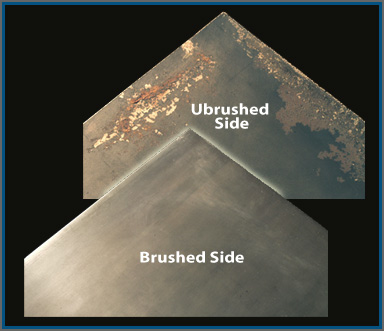Rust Resistance
Such corrosion resistance will extends the 'shelf life' of your steel and, combined with the absence of an oil coating, offers:
- Reduced paint prep
- Reduced welding fumes
- No need to grind off rust
- Cleaner work environment
- No skin irritation from oil
- No more rejects for rust
"I can’t emphasize enough how the cleanliness and rust resistance of SCS has helped us."
Again, SCS processing removes light to medium surface rust and leaves the treated steel surface smooth and corrosion resistant. That makes it a great way to restore value of rust-damaged inventory.
In February 2002, a sheet of hot rolled was SCS brushed on just one side. This photograph shows how the 'unbrushed' side has developed extensive surface rust. The 'brushed' side has no visible oxidation at all – testament to the long RUST FREE shelf life the SCS process offers for low carbon sheet steel.
The extent to which the SCS process can remove surface rust is impressive. The coil at the top is shown just before it was run through an SCS Coil Line. The bottom photo is the very same coil minutes after completing SCS processing. The coil has gone from 'secondary' to 'primary' material in a few minutes. What's more, RUST WILL NOT RETURN to this coil under normal indoor storage conditions.
To compare SCS steel corrosion resistance to HRPO, these samples were exposed to 98% relative humidity at 100°F to induce rusting. The top left shows a sample that was 'immersion pickled' (dipped) and oiled. At 300 hours it had developed substantial surface rust. The top right sample was continuous 'in-line pickled' and oiled. At 384 hours, you see noticeable rust developing along the edge (red arrows).
The bottom shows bare SCS (no oil) steel. It did not show rust until the 504 hour inspection. Even then, rust only occurred at the sheared edge where the protective scale layer had been disrupted (red arrows). Click here for full details.
The bottom shows bare SCS (no oil) steel. It did not show rust until the 504 hour inspection. Even then, rust only occurred at the sheared edge where the protective scale layer had been disrupted (red arrows). Click here for full details.
This shows a typical appearance after surface rust has been removed by the SCS process. The 'BEFORE' photo shows a spot of surface rust on hot band. The 'AFTER' photo shows all rust is removed by the SCS process – only a faint stain from the spot remains. This stain presents no problems for paint appearance or protection, and RUST WILL NOT REFORM there if the material is stored in a dry indoor environment.

